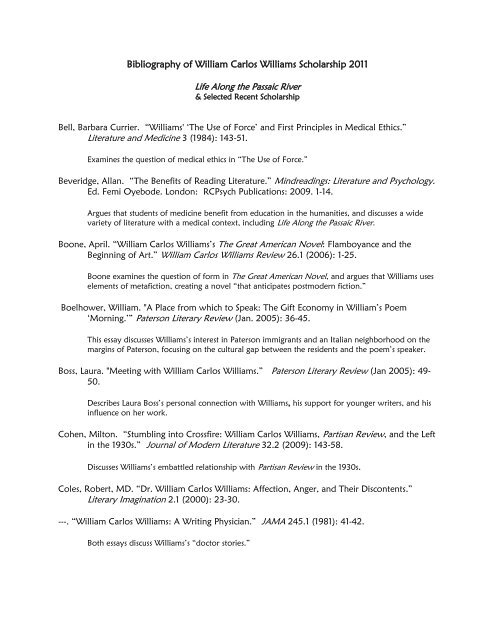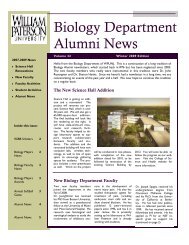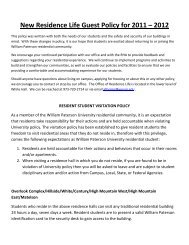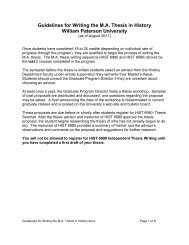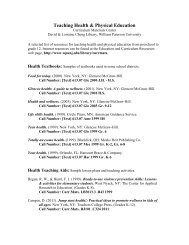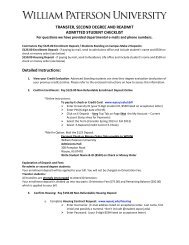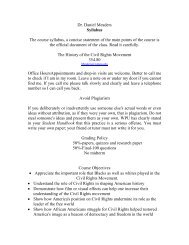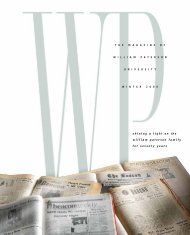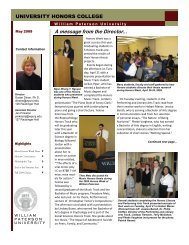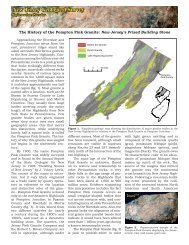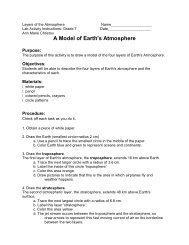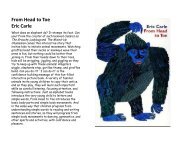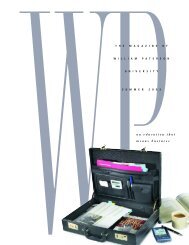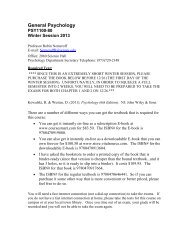Bibliography of William Carlos Williams Scholarship 2011
Bibliography of William Carlos Williams Scholarship 2011
Bibliography of William Carlos Williams Scholarship 2011
Create successful ePaper yourself
Turn your PDF publications into a flip-book with our unique Google optimized e-Paper software.
<strong>Bibliography</strong> <strong>of</strong> <strong>William</strong> <strong>Carlos</strong> <strong>William</strong>s <strong>Scholarship</strong> <strong>2011</strong><br />
Life Along the Passaic River<br />
& Selected Recent <strong>Scholarship</strong><br />
Bell, Barbara Currier. “<strong>William</strong>s' „The Use <strong>of</strong> Force‟ and First Principles in Medical Ethics.”<br />
Literature and Medicine 3 (1984): 143-51.<br />
Examines the question <strong>of</strong> medical ethics in “The Use <strong>of</strong> Force.”<br />
Beveridge, Allan. “The Benefits <strong>of</strong> Reading Literature.” Mindreadings: Literature and Psychology.<br />
Ed. Femi Oyebode. London: RCPsych Publications: 2009. 1-14.<br />
Argues that students <strong>of</strong> medicine benefit from education in the humanities, and discusses a wide<br />
variety <strong>of</strong> literature with a medical context, including Life Along the Passaic River.<br />
Boone, April. “<strong>William</strong> <strong>Carlos</strong> <strong>William</strong>s‟s The Great American Novel: Flamboyance and the<br />
Beginning <strong>of</strong> Art.” <strong>William</strong> <strong>Carlos</strong> <strong>William</strong>s Review 26.1 (2006): 1-25.<br />
Boone examines the question <strong>of</strong> form in The Great American Novel, and argues that <strong>William</strong>s uses<br />
elements <strong>of</strong> metafiction, creating a novel “that anticipates postmodern fiction.”<br />
Boelhower, <strong>William</strong>. "A Place from which to Speak: The Gift Economy in <strong>William</strong>‟s Poem<br />
„Morning.‟” Paterson Literary Review (Jan. 2005): 36-45.<br />
This essay discusses <strong>William</strong>s‟s interest in Paterson immigrants and an Italian neighborhood on the<br />
margins <strong>of</strong> Paterson, focusing on the cultural gap between the residents and the poem‟s speaker.<br />
Boss, Laura. "Meeting with <strong>William</strong> <strong>Carlos</strong> <strong>William</strong>s.” Paterson Literary Review (Jan 2005): 49-<br />
50.<br />
Describes Laura Boss‟s personal connection with <strong>William</strong>s, his support for younger writers, and his<br />
influence on her work.<br />
Cohen, Milton. “Stumbling into Crossfire: <strong>William</strong> <strong>Carlos</strong> <strong>William</strong>s, Partisan Review, and the Left<br />
in the 1930s.” Journal <strong>of</strong> Modern Literature 32.2 (2009): 143-58.<br />
Discusses <strong>William</strong>s‟s embattled relationship with Partisan Review in the 1930s.<br />
Coles, Robert, MD. “Dr. <strong>William</strong> <strong>Carlos</strong> <strong>William</strong>s: Affection, Anger, and Their Discontents.”<br />
Literary Imagination 2.1 (2000): 23-30.<br />
---. “<strong>William</strong> <strong>Carlos</strong> <strong>William</strong>s: A Writing Physician.” JAMA 245.1 (1981): 41-42.<br />
Both essays discuss <strong>William</strong>s‟s “doctor stories.”
Copestake, Ian, ed. The Legacy <strong>of</strong> <strong>William</strong> <strong>Carlos</strong> <strong>William</strong>s: Points <strong>of</strong> Contact. Cambridge:<br />
Cambridge Scholars P, 2007.<br />
A collection <strong>of</strong> essays that examine <strong>William</strong>s‟s contribution to various 20 th -century branches <strong>of</strong><br />
poetics as well as his connections to modernism, abstract impressionism, surrealism, and other<br />
cultural movements that influenced the development <strong>of</strong> American poetry.<br />
---. Rigor <strong>of</strong> Beauty: Essays in Commemoration <strong>of</strong> <strong>William</strong> <strong>Carlos</strong> <strong>William</strong>s. New York: Peter<br />
Lang, 2004.<br />
A collection <strong>of</strong> seventeen essays that examine the modernist dimensions and development <strong>of</strong><br />
<strong>William</strong>s‟s poetry, fiction, drama, and non-fiction. Highlighted are <strong>William</strong>s‟s influence on<br />
younger poets, the importance <strong>of</strong> the American idiom on <strong>William</strong>s‟s poetics; and a separate<br />
section, distinguished by two long essays by Gary Grieve-Carlson and Mark C. Long that focus on<br />
Paterson.<br />
Crawford, T. Hugh. Modernism, Medicine, and <strong>William</strong> <strong>Carlos</strong> <strong>William</strong>s. Norman: U <strong>of</strong><br />
Oklahoma P, 1995.<br />
Examines the concurrent development <strong>of</strong> modernism and the pr<strong>of</strong>essionalism <strong>of</strong> medicine in the<br />
United States, and explores scientific perspectives that are present throughout <strong>William</strong>s‟s work.<br />
---. “The Politics <strong>of</strong> Narrative Form.” Literature and Medicine 11.1 (1992): 147-162.<br />
Discusses narration in “Mind and Body.”<br />
Entin, Joseph B. Sensational Modernism: Experimental Fiction and Photography in Thirties<br />
America. Chapel Hill: U <strong>of</strong> North Carolina P, 2007.<br />
Entin examines fiction and photography <strong>of</strong> the 1930s that adopts the “sensationalism” <strong>of</strong> popular<br />
culture, such as tabloids or pulp fiction, in order to show the injustices inflicted on the working<br />
class, as evidenced in their damaged and disfigured bodies. Contains an extended study <strong>of</strong> Life<br />
Along the Passaic River.<br />
Favis, Roberta Smith. “Painting „the Red City.‟” American Art 17.1 (Spring 2003): 26-47.<br />
Favis explores the “sense <strong>of</strong> place” that both Bluemner and <strong>William</strong>s found in the city <strong>of</strong> Paterson,<br />
examining the connection between Oscar Bluemner‟s paintings <strong>of</strong> Paterson‟s silk factories and<br />
<strong>William</strong>s‟s writing, especially Paterson. Just as <strong>William</strong>s believed that Paterson was an appropriate<br />
subject for contemplation by “the mind <strong>of</strong> modern man,” Bluemner believed that Paterson, with<br />
its history <strong>of</strong> immigration and labor struggle, could serve as a symbol <strong>of</strong> the essence <strong>of</strong> America.<br />
Flanagan, Ian. “Hearing the American Voice: Thomas Kinsella and <strong>William</strong> <strong>Carlos</strong> <strong>William</strong>s,” Irish<br />
Studies Review 16.3 (2008):<br />
Honorable mention, Louis Martz Prize 2009.<br />
2
Gish, Robert F. "Rare Presences: The Knife <strong>of</strong> the Times and Life Along the Passaic River."<br />
<strong>William</strong> <strong>Carlos</strong> <strong>William</strong>s, A Study <strong>of</strong> the Short Fiction. Boston: G. K. Hall, 1989. 39-78.<br />
A study <strong>of</strong> thematics and stylistics in <strong>William</strong>s's short fiction.<br />
Hahn, Stephen. "It was … civilization I was after": George Tice, <strong>William</strong> <strong>Carlos</strong> <strong>William</strong>s, and the<br />
Archaeology <strong>of</strong> Paterson.” Literary Review 50.4 (Summer 2007): 62-82.<br />
A thorough and insightful review <strong>of</strong> two books that engage the sense <strong>of</strong> place <strong>of</strong> Paterson:<br />
Paterson, and Paterson II, by photographer George Tice.<br />
Hardy, Sarah Boykin. “The Art <strong>of</strong> Diagnosis.” Narrative 6.2 (1998): 157-73.<br />
A comparative analysis <strong>of</strong> the short fiction <strong>of</strong> Poe and <strong>William</strong>s, and the use <strong>of</strong> a “medical slant” in<br />
these works. Discusses “A Face <strong>of</strong> Stone.”<br />
Hillringhouse, Mark. "Looking at Paterson.” Paterson Literary Review (Jan. 2005): 51-54.<br />
Examines the influence <strong>of</strong> the city <strong>of</strong> Paterson city to the poem Paterson. Contains a description <strong>of</strong><br />
the city, the references to Paterson, and examines <strong>William</strong>s‟s choice <strong>of</strong> Paterson as a subject for a<br />
book-length poem.<br />
Hsiao, Irene. “Early <strong>William</strong> <strong>Carlos</strong> <strong>William</strong>s: Bad Keats?” The Cambridge Quarterly 37 (2008):<br />
Awarded 2009 Louis Martz Prize for best essay on <strong>William</strong>s published outside the WCW<br />
Review.<br />
Johnson, Bob. "A Whole Synthesis <strong>of</strong> His Time": Political Ideology and Cultural Politics in the<br />
Writings <strong>of</strong> <strong>William</strong> <strong>Carlos</strong> <strong>William</strong>s, 1929-1939." American Quarterly 54.2 (2002): 179-<br />
215.<br />
Considers <strong>William</strong>s‟s politics, especially in his “Depression writings,” including Life Along the<br />
Passaic River.<br />
King, Nancy M.P., and Ann Folwell Stafford. “Patient Stories, Doctor Stories, and True Stories: A<br />
Cautionary Reading.” Literature and Medicine 11.2 (1992): 185-199.<br />
Discusses “Face <strong>of</strong> Stone.”<br />
Kinnell, Galway. "Don‟t Cure It, Cultivate It: Visiting <strong>William</strong> <strong>Carlos</strong> <strong>William</strong>s in the Late<br />
Fifties.” Paterson Literary Review (Jan 2005): 14-14.<br />
Recounts Kinnell‟s personal interaction with <strong>William</strong>s during a visit to Rutherford, New Jersey.<br />
3
Koch, Vivienne. “The Novels and Short Stories." <strong>William</strong> <strong>Carlos</strong> <strong>William</strong>s. New York: New<br />
Directions, 1950. 187-246.<br />
An examination <strong>of</strong> <strong>William</strong>s's fiction before 1950, including The Knife <strong>of</strong> the Times and Life along<br />
the Passaic River. Koch argues for their importance in the development <strong>of</strong> <strong>William</strong>s‟s career and <strong>of</strong><br />
the modern American short story.<br />
Laughlin, James. Remembering <strong>William</strong> <strong>Carlos</strong> <strong>William</strong>s. New York: New Directions, 1995.<br />
Laughlin, <strong>William</strong>s‟s editor at New Directions, <strong>of</strong>fers a brief recollection and fond anecdotes that<br />
recall his relationship with <strong>William</strong>s.<br />
Lunberry, Clark. "So Much Depends: Printed Matter, Dying Words, and the Entropic Poem."<br />
Critical Inquiry 30.3 (Spring 2004): 627-653.<br />
Examines the friendship and relationship between <strong>William</strong>s and Robert Smithson, the well-known<br />
New Jersey artist.<br />
MacGowan, Christopher J. The Twentieth-Century American Fiction Handbook (Blackwell<br />
Guides to Literature). Malden, MA: Wiley-Blackwell, <strong>2011</strong>.<br />
---. Twentieth-Century American Poetry (Blackwell Guides to Literature). Malden, MA: Wiley-<br />
Blackwell, 2004.<br />
Marsh, Alec. “The Poet as a Man <strong>of</strong> Action: Emersonian Reflection on <strong>William</strong>s‟ The Wedge.”<br />
College Hill Review 6 (2010): n. pag. Web. 26 May <strong>2011</strong>.<br />
Traces Emersonian influence and tendencies, following the work <strong>of</strong> <strong>William</strong> James, in The Wedge,<br />
arguing for the usefulness <strong>of</strong> Richard Poirier‟s approach to <strong>William</strong>s in Poetry and Pragmatism<br />
(1992) and The Renewal <strong>of</strong> Literature: Emersonian Reflections (1987).<br />
Monteiro, George. “The Doctor's Black Bag: <strong>William</strong> <strong>Carlos</strong> <strong>William</strong>s' Passaic River Stories.”<br />
Modern Language Studies 13. 1 (1983): 77-84.<br />
Examines <strong>William</strong>s‟s dual careers as physician and writer, and the ways in which those callings<br />
interact in his Passaic River stories.<br />
Perl<strong>of</strong>f, Marjorie. “The Man Who Loved Women: The Medical Fictions <strong>of</strong> <strong>William</strong> <strong>Carlos</strong><br />
<strong>William</strong>s." The Georgia Review 34.4 (1980): 840-53.<br />
An examination <strong>of</strong> psychosexual aspects <strong>of</strong> doctor-patient relationships in several “doctor stories”<br />
in Life along the Passaic River.<br />
Rozendal, Michael. “Forms <strong>of</strong> Need: <strong>William</strong> <strong>Carlos</strong> <strong>William</strong>s in the Radical Thirties Little<br />
Journals.” <strong>William</strong> <strong>Carlos</strong> <strong>William</strong>s Review 27.2 (2007): 137-155.<br />
A study <strong>of</strong> <strong>William</strong>s‟s story “Jean Biecke,” which appeared in the first issue <strong>of</strong> Blast, and <strong>William</strong>s‟s<br />
desire to create a form that would respond to the social needs <strong>of</strong> the time.<br />
4
Slate, J.E. "<strong>William</strong> <strong>Carlos</strong> <strong>William</strong>s and the Modern Short Story." The Southern Review 4.3<br />
(1968): 647-64.<br />
Slate relates <strong>William</strong>s's theories about writing short fiction to the stories themselves, demonstrating<br />
the modern qualities <strong>of</strong> <strong>William</strong>s's thought and practice.<br />
Wagner, Linda Welshimer. "The Shape <strong>of</strong> Men's Lives." The Prose <strong>of</strong> <strong>William</strong> <strong>Carlos</strong> <strong>William</strong>s.<br />
Middlebury, CT: Wesleyan UP, 1970. 104-20.<br />
Wagner surveys <strong>William</strong>s's short fiction, relating its subjects and techniques to those <strong>of</strong><br />
contemporaneous writings.<br />
Walton, Eda Lou. “X-Ray Realism.” Rev. <strong>of</strong> Life Along the Passaic River. The Nation 146.12 (28<br />
March 1938): 334-35.<br />
Early review <strong>of</strong> the book upon its publication by New Directions in 1938 – priced at $1.95. In<br />
Walton‟s words, “Dr. <strong>William</strong>s takes no detours around life” in the collection <strong>of</strong> “sketches,” as she<br />
calls them. Brutally honest in their representation <strong>of</strong> life in the “Passaic river town,” the collected<br />
stories, Walton claims, <strong>of</strong>fer the reader “the shock <strong>of</strong> observing bone suddenly and cleanly<br />
unfleshed.”<br />
<strong>William</strong>s, <strong>William</strong> <strong>Carlos</strong>. "A Beginning on the Short Story (Notes)," in Selected Essays <strong>of</strong> <strong>William</strong><br />
<strong>Carlos</strong> <strong>William</strong>s. New York: Random House, 1954. 295-310.<br />
Witemeyer, Hugh. “<strong>William</strong> <strong>Carlos</strong> <strong>William</strong>s' Introduction to His Short Stories: A History and<br />
Some Interpretive Uses.” Journal <strong>of</strong> Modern Literature 18.4 (1993): 435-46.<br />
A close examination <strong>of</strong> a 48-page typescript sent by <strong>William</strong>s in 1960 to his editor at New<br />
Directions, James Laughlin.<br />
5<br />
Prepared by Judith Broome<br />
Department <strong>of</strong> English<br />
<strong>William</strong> Paterson University<br />
June <strong>2011</strong>


